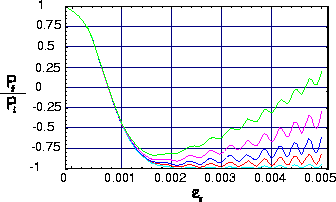
| |
| ELSA-Facility | |
| Accelerator physics: | |
| Home page | |
| Group members | |
| Accelerator | |
|
|
Research & development |
| Publications | |
| Teaching | |
| Experiments at ELSA: | |
| Hadron physics | |
| Polarized target | |
| Test beam | |
| Informations for users: | |
| Beam schedule | |
| Accelerator status | |
| SFB/Transregio 16 | |
| Radiation protection | |
| Job offers | |
| Additional links | |
| Guided tours | |
| Contact | |
 |
Deutsche Version |
Polarized Electrons in ELSA
Introduction
Polarized electrons are an important requirement for many experiments at ELSA. Production and acceleration of polarized electrons is one of the main fields of research at ELSA. Following parts belong to this:- The polarized sources
- Depolarization in the booster synchrotron
- Depolarizing resonances in the stretcher ring
- Tunejump magnet system for fast crossing of intrinsic resonances
- Fast closed orbit correction system for dynamic correction of imperfection resonances
- Compton polarimeter
- Møller polarimeter
In order to preserve the polarization level to the experimental target, several depolarizing resonances (both in the booster and in the storage ring) have to be crossed and corrected. This has been successfully done in several proton accelerators but not yet in an electron storage ring. Some calculations will be presented to show the differences. The applied correction techniques also differ from the scheme which is applied in high energy electron storage rings to obtain a high equilibrium polarization.
Depolarizing Resonances
 During acceleration in the synchrotron
and in ELSA at certain energies resonances are crossed which reduce the
polarization degree of the electrons. Two types of resonances are important,
the so called imperfection resonances due to vertical closed orbit distortions
(independent of the special design of the machine every 440.65 MeV) and
the intrinsic resonances which are related to vertical betatron oscillations.
During acceleration in the synchrotron
and in ELSA at certain energies resonances are crossed which reduce the
polarization degree of the electrons. Two types of resonances are important,
the so called imperfection resonances due to vertical closed orbit distortions
(independent of the special design of the machine every 440.65 MeV) and
the intrinsic resonances which are related to vertical betatron oscillations.
Earlier measurements had shown only a small electron depolarization in the booster synchrotron below the third imperfection resonance (1.32 GeV). If the transfer energy between synchrotron and ELSA is kept below this energy no correction elements for the synchrotron are necessary.
In ELSA the behaviour of the polarization during post acceleration has to be investigated. Calculations and first measurements show that some of the possible intrinsic resonances (at 2.0, 2.9 and 3.3 GeV) are strong and have to be corrected in any case. For this purpose a scheme with two pulsed quadrupoles has been designed. The required hardware (two Panofsky-type quadrupoles built of ferrites and the power supplies) has been manufactured, installed and tested.
Intrinsic Resonances
The strength of an intrinsic resonance is different for each individual particle and depends on its vertical betatron amplitude. There are two possibilities to avoid depolarization: For small resonance strength or high crossing speed the polarization vector stays unchanged. For high strength or low crossing speed a spinflip (with conservation of the absolute value) is possible. For an electron accelerator like ELSA, the second possibility is not applicable for intrinsic resonances. To reduce the strength of intrinsic resonances, tests to decrease the emittance coupling have been done. A coupling ratio of less than 5 % could be achieved during the whole ramping phase (below 1 % during flat top). But even then, three of the intrinsic resonances are sufficiently strong to cause a significant depolarization. So additionally the crossing speed has to be increased. For this purpose a pulsed system of Panofsky type tunejump quadrupoles with ferrite yokes has been designed that shifts the vertical tune rapidly during resonance crossing.Imperfection Resonances
The strength of imperfection resonances is roughly proportional to the average vertical closed orbit distortions. Unfortunately, the achievable overall orbit quality during ramping is not sufficient to avoid a significant depolarization. Therefore one concentrates on the closed orbit harmonic(s) that is (are) driving a specific resonance. Because the crossing speed of imperfection resonances is determined by the ramping speed only (which is more or less fixed), the only parameter to vary is the resonance strength.Adiabatic Spinflip
 The spin motion in an electron storage
ring is strongly affected by the synchrotron motion and the stochastic
emission of synchrotron radiation. Therefore the dependence of the final
polarization on the resonance strength is more complicated. These calculations
show that it is possible to achieve a nearly perfect spinflip up to the
4th imperfection resonance at ELSA. The required resonance strength is
about 2 x 10-3. This can easily be achieved by the help of two
existing correctors and the required closed orbit distortion will be safely
inside the machine aperture. The advantage of a spinflip over a harmonic
correction is the smaller sensitivity to corrector and measurement errors.
Thus it is fast to optimize and should be very reproducible once established.
At higher energies a spinflip is still possible, but is combined with significant
depolarization. Therefore a harmonic correction scheme is used for these
resonances.
The spin motion in an electron storage
ring is strongly affected by the synchrotron motion and the stochastic
emission of synchrotron radiation. Therefore the dependence of the final
polarization on the resonance strength is more complicated. These calculations
show that it is possible to achieve a nearly perfect spinflip up to the
4th imperfection resonance at ELSA. The required resonance strength is
about 2 x 10-3. This can easily be achieved by the help of two
existing correctors and the required closed orbit distortion will be safely
inside the machine aperture. The advantage of a spinflip over a harmonic
correction is the smaller sensitivity to corrector and measurement errors.
Thus it is fast to optimize and should be very reproducible once established.
At higher energies a spinflip is still possible, but is combined with significant
depolarization. Therefore a harmonic correction scheme is used for these
resonances.
Harmonic Correction
The aim of the harmonic correction is the reduction of the degrees of freedom of the optimization problem by correcting only the closed orbit harmonics relevant for the actual resonance. Therefore it is possible to optimize the initial corrector settings calculated from closed orbit data by measurements of the actual depolarization.An existing set of correction dipoles, used for closed orbit corrections, can be used for compensating the depolarizing effects which occur from the imperfection resonances (by forcing a spinflip at the resonance at 1.32). For higher energies this scheme is not applicable due to the strong synchrotron motion of the electrons and the influence of synchrotron radiation on the spinflip. Therefore for the imperfection resonances above 2 GeV a harmonic correction will be used. For this purpose the existing corrector system has been upgraded (new power supplies and new control electronics).
Tunejump Quadrupoles
Even at maximum ramping speed and with emittance coupling ratios of 1%, three of the intrinsic resonances at ELSA are sufficiently strong to cause a significant depolarization. Since synchrotron radiation effects prevent an application of the spinflip technique, the crossing speed has to be increased. For this purpose a system of pulsed Panofsky type quadrupoles with ferrite yokes has been designed that shifts the vertical tune rapidly during resonance crossing. The design was optimized with respect to the inductance of the magnet and the multipole composition of the field. The main problem causing higher multipole components is the skin effect (the rise time of the magnet is 10 µs). This has been simulated and a coil arrangement was chosen to minimize the unwanted multipoles. The field map and the inductance of the magnet have been measured in detail. The field gradient is 1.2 T/m with two windings at 500 A, the higher multipoles are negligible and the inductance is about 9 µH.Spintracking Studies
To study the influence of synchrotron oscillations and synchrotron radiation on the spin motion and to make reliable predictions of the polarization behaviour in ELSA at energies where it is currently impossible to measure this behaviour due to the strong depolarization at 2.0 GeV, a spintracking program has been written. It is based on the approach of spinor transfer maps, which has been used earlier for the case of protons. In the proton case one turn transfer maps were used, since all relevant
processes there are slow compared to the revolution frequency. Unfortunately,
for electrons a large number of photons is radiated during one revolution
so that this approach is not applicable. Instead a full tracking of the
motion in the longitudinal phase space has been implemented. Individual
transfer maps for each dipole of ELSA are used and the energy loss due
to synchrotron radiation is calculated between each of these transfer maps.
Using this program to simulate the crossing of depolarizing resonances
gives results in good agreement with the measurements. However, to reach
this agreement an additional coherent synchrotron oscillation with an amplitude
of about twice the equilibrium energy spread had to be included into the
tracking. Indeed, these oscillations have been observed during the measurements
and may be attributed to longitudinal multibunch modes and synchro-betatron
resonances during ramping. The amplitude needed to reproduce the effect
in the tracking is in rough agreement with the amplitude measured in the
longitudinal bunch spectrum.
In the proton case one turn transfer maps were used, since all relevant
processes there are slow compared to the revolution frequency. Unfortunately,
for electrons a large number of photons is radiated during one revolution
so that this approach is not applicable. Instead a full tracking of the
motion in the longitudinal phase space has been implemented. Individual
transfer maps for each dipole of ELSA are used and the energy loss due
to synchrotron radiation is calculated between each of these transfer maps.
Using this program to simulate the crossing of depolarizing resonances
gives results in good agreement with the measurements. However, to reach
this agreement an additional coherent synchrotron oscillation with an amplitude
of about twice the equilibrium energy spread had to be included into the
tracking. Indeed, these oscillations have been observed during the measurements
and may be attributed to longitudinal multibunch modes and synchro-betatron
resonances during ramping. The amplitude needed to reproduce the effect
in the tracking is in rough agreement with the amplitude measured in the
longitudinal bunch spectrum.
In 1997 first intensive studies of resonance crossing and correction of depolarizing resonances have been carried out. More details can be found in a NIM article (Nucl. Instr. and Meth. A 411 (1998) 93-106).
 Printer version
Printer version
|
 Deutsche Version
Deutsche Version
|
Imprint | Data privacy statement |